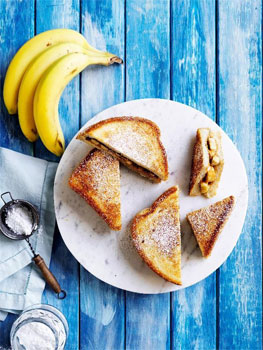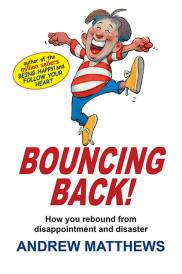Elvis Banana and Peanut Butter Pan Toasties

Makes: 2
Prep: 10 mins
Cooking: 6 mins
Ingredients
4 tbs smooth peanut butter
4 thick slices white bread
2 Cavendish bananas, peeled
2 tbs butter, softened
Icing sugar, to serve
Method
Spread 1 tablespoon of peanut butter over each slice of bread. Slice the banana and arrange over two slices of the bread. Sandwich together with remaining bread, peanut butter side-down. Butter both sides of each sandwich.
Place the sandwiches in a large non-stick frying pan over medium heat. Cook for 3-4 minutes or until golden. Turn and cook for 2 minutes or until golden.
Transfer to a board. Dust with icing sugar, cut in half and serve.
Tip: To make choc peanut butter banana toasties, replace 2 tablespoons of peanut butter with chocolate hazelnut spread. Spread peanut butter over two slices of bread, and chocolate spread over two slices. Slice the banana and arrange over peanut butter. Sandwich together with chocolate hazelnut spread side down.
15 Reasons Australian Bananas are so Ap-peeling
Banana power
Cyclists, tennis players, triathletes and just about anybody involved in sport love to eat bananas before, during or straight after training.
Research shows that having two bananas an hour (with water) works just as well as sports drinks on a 75km bike ride. The banana breaks down in digestion to give natural sugars that fuel the muscles, making it the perfect sports snack.
The perfect pick-me-up
Carbohydrate snacks are very useful for bringing low blood glucose levels back to normal and help avoid the mid-afternoon slump often experienced at work. Healthy blood glucose control is helped by snacking on carbohydrate foods every 2-4 hours to keep levels steady. Wholesome carbohydrate snacks are very useful for clear thinking, improved memory and mood. Bananas are ideal, because of their low Glycaemic Index and zero fat level.
Low glycaemic index
The average Glycaemic Index of bananas is 52, even less for under-ripe bananas as they have a higher starch content and a lower sugar content. A GI of 52 is classified as low, meaning that it doesn't cause high blood sugar levels. That makes the banana a particularly good fruit choice for people with diabetes.
Vitamin vitality
Australian Bananas are the best fruit source of vitamin B6. One banana provides about 15 per cent of your daily needs. Vitamin B6 helps with the production of neurotransmitters including serotonin and gamma-aminobutyric acid (GABA). The older you get, the more B6 your body needs. The banana is also a wonderful source of vitamin C, along with modest amounts of the B group vitamins niacin, riboflavin and pantothenic acid.
Antioxidant armour
Antioxidants are well known to be playing a role, in reducing the risk of early disease. Scientific research confirms that bananas have significant antioxidant power helping to protect the body from future disease via their positive effect on blood and nerves. Bananas have antioxidant compounds such as vitamin C and phenols.
Size matters
In addition to the medium-sized bananas, many retailers now stock the smaller -lunchbox' banana which is perfect for school kids who prefer a smaller serve. In fact, anyone with a small appetite or those who just like frequent snacks can dine on the convenient lunchbox banana.
Normal blood pressure
This unique tropical fruit is extremely high in potassium and salt-free, making it perfect for a healthy blood pressure. Australian and international research show that a diet high in potassium and low in salt helps to keep blood pressure normal. Less than one in 10 people get enough potassium to reduce their risk of chronic disease, like stroke. That leaves a lot of room for high potassium foods like the banana.
Happy on the inside
We all know that high fibre foods help keep you regular and prevent constipation. The fibre in bananas can go a long way in helping restore normal bowel action, without resorting to laxatives. A medium banana will provide about 10% of your fibre needs for a day. The banana is also the best fruit source of resistant starch, a type of starch known to help protect you against bowel cancer.
Appetite control
Bananas are high satiety meaning they are very filling for the amount of kilojoules they provide. If you are trying to maintain a healthy weight then eat plenty of fruit and vegetables and go easy on the fatty foods.
How do you open a banana?
You most probably open it from the end with the -pull tab'. That's fine, but sometimes that pull tab can be quite thick and tricky to snap. The other option is to squeeze the other end which may be softer. It will split with ease then you can peel as you would normally.
Australian Bananas are grown in the tropical areas of Queensland, Northern Territory, Western Australia and northern New South Wales. Elsewhere is just a bit too chilly for them. Bananas are Australia's favourite fruit – we enjoy over 5 million bananas every day. That's a lot of people getting some long-lasting energy.
Keeping slim
One medium banana has only one third of the calories you find in a small pack of crisps or corn chips, and fewer calories than in a single chocolate biscuit. Choose your snacks wisely; the banana is a great choice.
How do you buy your banana?
Everyone knows that the banana goes from green to yellow over a week or so. If you buy some yellow bananas, don't forget to also buy some green ones too, so once the yellow ones have been devoured the green ones have become ripe. You can delay ripening by placing it in the vegetable crisper of the fridge. You may get some browning of the skin, but the banana inside will still be delicious.
Speeding up the ripening process.
Try placing your bananas in a fruit bowl with other ripe fruit, or put bananas in a paper bag with a ripe fruit (e.g. apple or avocado). The natural ethylene gas produced by the other fruit and the banana will circulate in the bag and speed up the ripening process.
And one for expectant mums
Folate is vital in the development of a baby's spinal cord in the womb. It is so critical that the vitamin is often recommended as a supplement to women considering pregnancy. An overwhelming body of evidence has linked adequate folate in early pregnancy to a lower risk of neural tube defects, such as spina bifida in infants. One banana will provide over 10 per cent of your folate needs each day.
For the latest news and information visit www.australianbananas.com.au and LIKE Australian Bananas on Facebook https://www.facebook.com/AustralianBananas and Instagram @australianbananas
MORE



